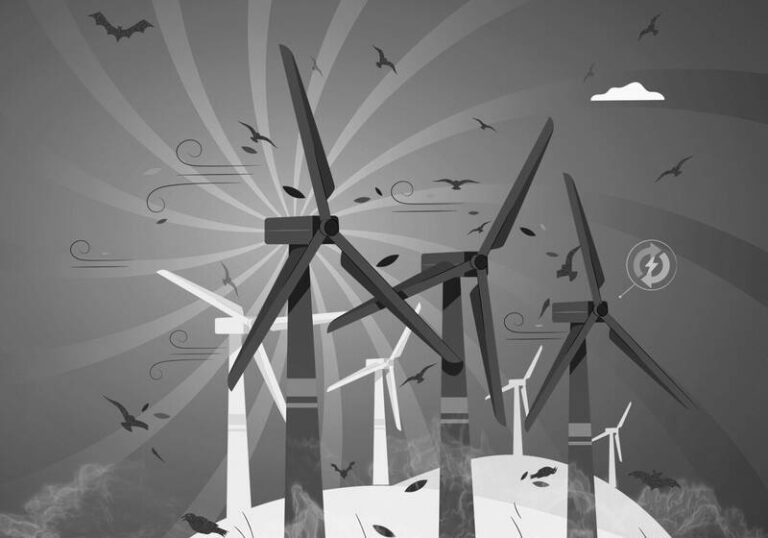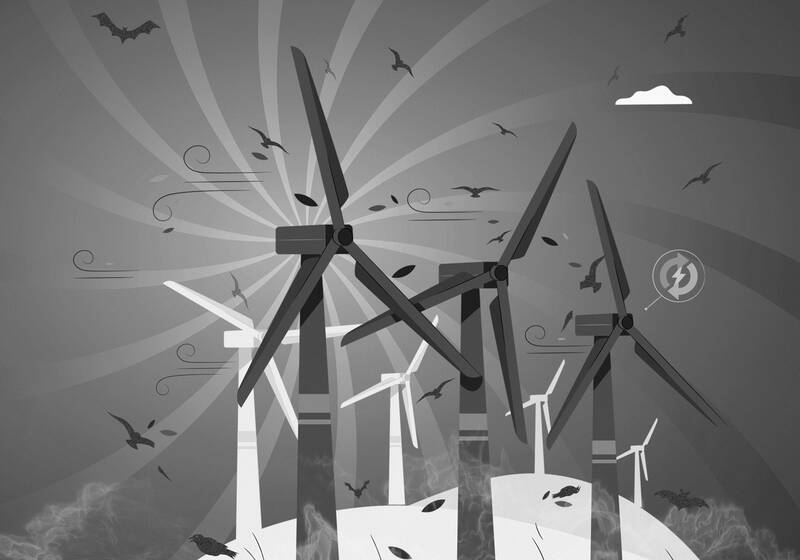
[ad_1]
If you are worried about the animals at a wind farm going up near you, do not oppose the project, but do demand that the developer implement known techniques to minimize fatalities
-
By Lara Williams / Bloomberg Opinion
Wind power might be having a difficult year, but it is still many times cheaper than oil or gas and remains a core piece of the energy-transition puzzle. A single rotation of a 260-meter-tall offshore turbine — General Electric Co’s Haliade-X 13MW, to be precise — produces enough energy to power a household for more than two days, emitting no carbon or other pollutants.
Not everyone is a fan. NIMBYism is one of the biggest barriers to green energy installations, as local residents protest “view-ruining” turbines and new grid infrastructure. Yet one concern regularly crops up that I have some sympathy for: how wind farms affect wildlife. After all, we are facing a biodiversity crisis, too, but where wind turbines are truly impacting animals, effective and often cheap mitigation measures are available.
Take bats for example. Our flying mammals are being taken out by wind turbines globally, either struck directly by a blade or suffering from barotrauma — damage to tissues from air pressure changes around turbines. One estimate puts annual bat fatalities somewhere between 600,000 and 900,000 in North America alone.

Illustration: Louise Ting
Research points to a simple solution. Rodrigo Medellin, an ecologist known as “the bat man of Mexico,” explained that, as a default, turbines typically start spinning at a wind speed of about 3 meters per second (mps): a gentle breeze.
Yet numerous studies have found that increasing the speed at which turbines become operational to 6mps reduces fatalities significantly. That is likely because insects, which certain species love to feast on, cannot fly at those higher wind speeds, so neither do the bats.
The cost in lost energy is negligible. If all turbines operated in that way, the annual energy losses would be just 1 percent. That feels worth it to save some vital pollinators and pest controllers.
It is now a legal requirement in the EU to curb wind farms during times of peak bat activity: in the migration season, when wind speeds are low and temperatures are mild. New technology promises smart curtailment, taking local bat activity, temperatures and wind speeds into consideration, continuing to reduce bat fatalities while minimizing potential energy loss.
In Africa and southern Europe, vultures have been struggling with wind turbines. Though these raptors have excellent eyesight to spot carrion on the ground, they have a tendency to miss the large white rotating towers that people have erected in their habitat. That is due to a sizable blind spot which stops them from seeing directly in front of them as they fly. It possibly evolved to help them avoid being blinded by the sun — an effective method until humans came along and added new obstacles.
There is plenty that could be done to help avoid collisions, such as clearing up carrion that attracts raptors to the area. Yet the best thing to do is just to stop the turbines. A study of 13 wind farms in Spain showed that selective stopping techniques — halting turbines when vultures fly too close — halved mortality rates with a reduction of just 0.07 percent in total energy production per year. This method is in operation at Kipeto wind farm in Kenya’s Rift Valley, which is close to a large colony of endangered Ruppell’s vultures. Last year, the bird-related shutdowns caused a loss of 0.014 percent of the year’s budgeted energy production.
For other bird species, a simple paint job might suffice. A 2020 Norwegian study at a wind farm that was killing white-tailed eagles found painting one blade black reduced the mortality rate by 70 percent. Projects in other regions are testing the technique and other designs, including striped blades.
The threat posed to wildlife has been weaponized by clean-energy skeptics. Former US president Donald Trump, for instance, mourned the death of “all the birds” killed by wind power on more than one occasion, but the truth is that the number of avian deaths from collisions with turbines pales in comparison with the 2.4 billion murdered every year by domestic cats.
Clean energy also kills far fewer animals than fossil-fuel power plants do. A 2012 study estimated that wind and nuclear energy kills 0.3 to 0.4 birds per gigawatt-hour (GWh) of electricity produced, compared with 5.2 birds killed per GWh of electricity from fossil fuel projects.
Recently, as more wind projects are installed on the east coast of the US, spurious connections have been made between the construction work and washed-up whales. Wind opponents claim that sonar-equipped exploration devices used to find wind farm sites are to blame, despite there being no evidence to back up their arguments. Never mind that wind developers have a legal obligation to ensure that there are not any marine mammals in the vicinity before using the sonar, and that the tools are much less powerful than those used in offshore oil and gas exploration.
I do not blame people for becoming wrapped up in these fears. A dead whale on a beach is a highly emotive symbol — more visible than the gigawatts of pollution-free electricity produced by wind turbines every year, and certainly more visible than the thousands of animals unaffected by clean energy installations.
Unfortunately, there are gaping holes in wind farms’ efforts to protect nature. About 75 percent of wind turbines are operating without bat curtailment in Germany due to them being built before EU regulations came in. There are also plenty of countries, such as Medellin’s Mexico, that have a dearth of rules in place to help protect bats or birds.
However, we should remember that, mitigated or not, turbines are far less destructive than the effects of untamed climate disasters. If you are worried about the animals at a wind farm going up near you, do not oppose the project, but do demand that the developer implement known techniques to minimize fatalities. We can have both wildlife and wind energy.
Lara Williams is a Bloomberg Opinion columnist covering climate change. This column does not necessarily reflect the opinion of the editorial board or Bloomberg LP and its owners.
Comments will be moderated. Keep comments relevant to the article. Remarks containing abusive and obscene language, personal attacks of any kind or promotion will be removed and the user banned. Final decision will be at the discretion of the Taipei Times.
[ad_2]
Source link